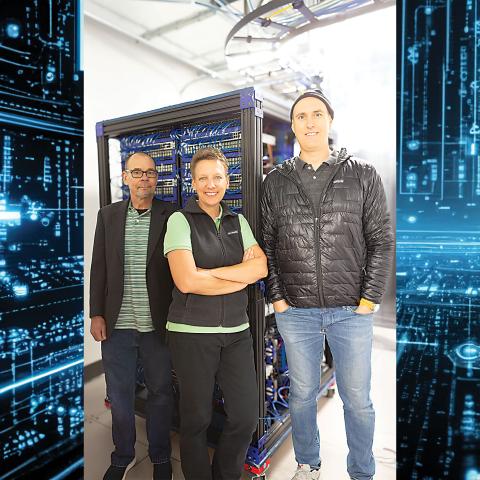World’s Largest Raspberry Pi Cluster Finds New Home at UCSB Computer Science

Bigger on the inside: Professors Rich Wolski and Chandra Krintz with engineer Chris Bensen and his creation.
What is it?
A supercomputer consisting of 1,050 Raspberry Pi 3B+. The next largest system that we know of is a cluster of 750 at Los Alamos National Lab.
Why is it?
The short answer, according to creator Chris Bensen in his series of videos detailing the project, is “because it kicks a**.” The longer answer lies in Oracle’s support for a series of outside-the-box projects designed to attract the attention of engineers and developers.
How did it get to UCSB?
It started with PhD student Animesh Dangwal’s internship at Oracle Labs. Professors Rich Wolski and Chandra Krintz explain that as a result of Dangwal’s outstanding work, his Oracle supervisor came to visit UCSB.
“In the course of discussing Animesh’s research, we mentioned that we do a lot with Raspberry Pis,” says Wolski.
They showed off their own cluster of 18 devices, and the supervisor wondered if their lab would like some more that Oracle wasn’t using.
“I’m thinking he had maybe 20,” Wolski says. “I said yeah, absolutely!” He thought they could make room in the shoe rack that houses their current cluster. “The next thing that happens, here come a thousand of these things.”
“This has been sitting at Oracle for two years not being used,” adds Krintz. “They really wanted someone to take it forward. There’s so much great technology here that they wanted to pass along for its next generation.”
How will we use it?
“Our students are going to go crazy on this,” says Wolski. “We’re going to use it in a couple of ways. We have large scale, high performance computing problems that we want to experiment with on a low power device. And from a high performance computing perspective, this is a very low power device. The other part is, we didn’t have an instrument like this where we can train students on the systems end of it. This is a significant system.”
“It’s very different if I taught you how to manage 12 Raspberry Pis,” says Krintz, “than it is to do something at this scale. This gives us the ability to train students in a way that nobody else on the planet can.”
“You can make donuts in your kitchen,” adds Wolski, “but if you want to make donuts for the Super Bowl, it’s different—this is the Super Bowl.”